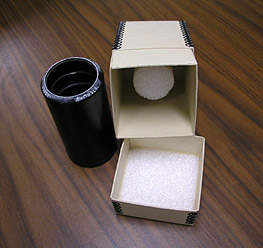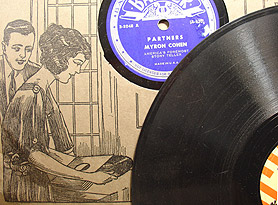
Inherent vice: early sound recordings
1 Cylinders | 2 Discs
|
|
Before the advent of magnetic tape (and later, compact disc), sound recordings were made by picking up sound vibrations and transmitting them to a stylus, which etched them into the surface of a rotating cylinder or disc. The earliest recordings were acoustic, which, in simple terms, means that changes in air pressure were channeled through a horn to a diaphragm attached to the stylus and thus transformed into mechanical motions. Later recordings (after about 1925) used microphones, which transformed the changes in air pressure into changes in electrical voltage, which in turn made the stylus move.
These types of recordings are not as common in archival collections as magnetic tapes, but discs, in particular, are encountered fairly frequently.
1 Cylinders
|
|
The first cylinder recordings consisted of a brass cylinder covered with tin foil. These were soon replaced with wax and plastic cylinders of various types, which could be either prerecorded or recordable. "Soft wax" cylinders are usually original (not-prerecorded) recordings. They were actually made from a variety of materials, including wax, resins, soaps, and oils. Colorants, plasticizers, lubricants, and/or hardeners were sometimes added. Prerecorded cylinders ("molded cylinders") were first made from hardened wax or metallic soap and later from celluloid plastic.
Characteristics of Deterioration
The grooved surfaces of cylinders (particularly wax cylinders) are very vulnerable to damage, so cylinders should be handled only using the holes at the end of the cylinder, and always be stored standing on end. Wax cylinders are also very susceptible to mold at high relative humidity. Finally, it is important to note that wax cylinders should not be touched when they are cold, since warmth can cause the cold wax to fracture.
Cylinders made from hardened wax, metallic soap, or celluloid can become very fragile and brittle over time. Exposure to light, particularly UV light, will accelerate this deterioration.
2 Discs
Disc recordings made from a variety of materials were produced and used throughout the late 19th and early 20th centuries. Acetate discs were primarily used for amateur or DIY recordings, while other materials were used for manufactured commercial recordings.
The following information is summarized from Gilles St. Laurent's The Care and Handling of Recorded Sound Materials, which should be consulted for additional information.
Acetate Discs
Acetate discs are very unstable due to their coating of nitrocellulose lacquer plasticized with castor oil. The plasticizer gradually evaporates off, causing the lacquer coating to become brittle and shrink. This coating is bonded to a base (usually aluminum) that cannot shrink, so the coating cracks and peels off the base. Acetate discs are also subject to chemical reactions that result in the formation of acids, which further accelerate deterioration. As with other materials, these chemical reactions are made worse by high temperature and humidity.
Vulcanite Discs
These were made from vulcanized rubber (vulcanization made the rubber stronger and more elastic) and were first marketed by Berliner in the 1890s. Vulcanite discs are quite stable when stored in the dark, but very unstable when exposed to light and/or heat and humidity. Light facilitates the oxidation of the rubber, forming sulphur oxides and sulphuric acid in the presence of humidity. This acidity eventually causes the plastic to decompose.
Vulcanite discs also have characteristic problems such as warping, blisters, and particles that are a result of the production process.
Shellac Discs
Shellac discs were first introduced in the early 1900s. Early discs were made with an organic shellac binder (produced from insect secretions) that covered a core. Later shellac discs were made from a plastic resin that was slightly more stable. Cores were made from many types of fillers with a wide range of quality (e.g., powdered limestone or slate, carbon black, lubricants, oils, resins). Therefore, making generalizations about the causes of deterioration is difficult.
Shellac discs are relatively stable, but are prone to slow embrittlement of the shellac coating. The curing process during the manufacture of shellac discs causes chemical reactions that eliminate water or ammonia molecules, causing embrittlement. This process continues, although more slowly, throughout the lifetime of the disc, and it is accelerated by high temperature and humidity.
Edison Diamond Discs
In 1911, the Edison Company began marketing a new disc made from a synthetic plastic called phenol. This plastic material formed the core of the disc, which was then coated with thin layers of varnish. These discs were quite stable and not prone to warping like others. However, prolonged contact with moisture or high humidity may damage them. These discs were designed to be played on Edison phonographs only and they were incompatible with other players. While they enjoyed significant popularity for some time, they were eventually supplanted by other types of discs. By 1929, they were no longer being produced.
Vinyl Discs
|
|
Vinyl discs were first introduced in 1930, but did not become popular until the late 1940s, when both 33 1/3 rpm long play vinyl records and the 45 rpm format were introduced. Vinyl discs are quite stable, even though they are made from polyvinyl chloride (PVC), which deteriorates upon exposure to light or heat. The deterioration process produces hydrochloric acid, which further accelerates the corrosion. To control this, a stabilizing chemical that consumes the hydrochloric acid is added during the manufacturing process. This generally provides enough protection for several decades.



